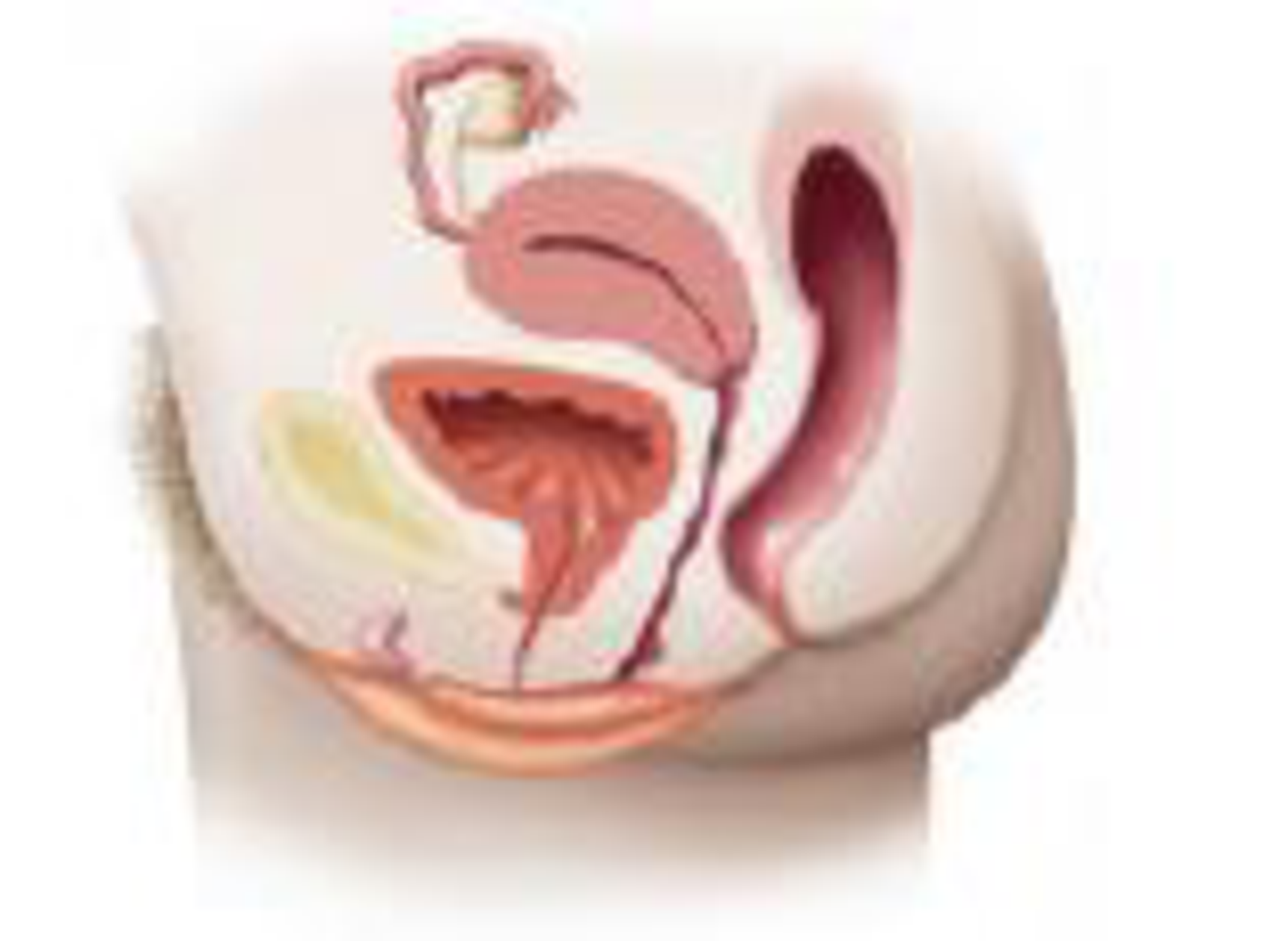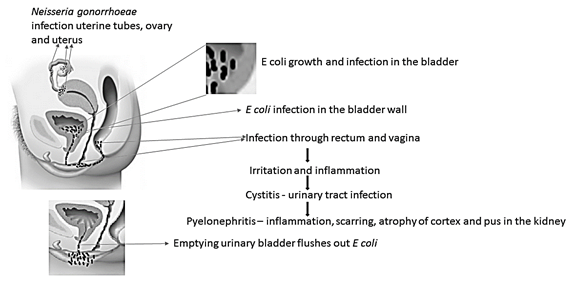
coli to cause cystitis. Do the same for pyelonephritis. Diagram the pathway taken by Neisseria gonorrhoeae to cause PID.

To draw:
Pathway taken by E. coli to cause cystitis and pyelonephritis. Pathway taken by Neisseria gonorrhoeae to cause PID
Pictorial representation:

Concept introduction:
Cystitis is a urinary tract infection, mostly caused by E coli. Bacterial growth in the urothelium of the bladder through rectum, urethra, perineum and vagina causes cystitis. Pyelonephritis is an inflammatory disease of kidneys, mostly caused by E coli. Bacteria can reach kidney through lower urinary tract and bloodstream. Pelvic inflammatory disease or PID is a severe bacterial infection of pelvic organs of women, mostly caused by N gonorrhoeae.
Explanation of Solution
Cystitis is a common urinary tract infection, caused by Escherichia coli (E coli) bacteria. Nearly 70-95% of the urinary tract infections are caused by E coli. It is a gram-negative, anaerobic, rod-shaped bacteria. It is commonly found in environment, skin and intestines of animal and human. Mostly they are harmless and help in digestion, and sometimes they can cause serious health problems like diarrhea, cystitis (urinary tract infections), respiratory problem, pneumonia, food poison and others. Cystitis is primarily caused by Escherichia coli and also by Staphylococcus saprophyticus, Klebsiella species, Proteus species and Enterobacter species. E coli covers the lining of the bladder and causes irritation and inflammation which leads to cystitis. Cystitis affects people in all age groups, however, it is more common in women than men due to the short urethra, which is less than 2 inches. The female urethra is very close to anal opening, hence it may lead to intestinal bacterial contamination. It can be prevented by drinking plenty of water which can flush bacteria and also with personal hygiene. Cystitis can be treated with antibiotics such as nitrofurantoin, trimethoprim - sulfamethoxazole, fluoroquinolone and ampicillin.
Pyelonephritis is an inflammatory disease of kidneys, caused by bacterial infection. It is a life-threatening disease which severely damages one or both kidneys and causes renal scarring. More than 70% of pyelonephritis is caused by E coli and rarely by Enterococcus faecalis, Pseudomonas aeruginosa and Klebsiella species. Bacteria can reach kidney through lower urinary tract and bloodstream. Initially, it infects bladder and move to kidney and severely damage one or both kidneys. Lower urinary tract infection is very vulnerable for kidney damage and pyelonephritis. Pyelonephritis is more common in women than men due to short urethra, which is less than 2 inches. The female urethra is very close to anal opening, hence it may lead to intestinal bacterial contaminations. Second or third generation cephalosporin is used to treat pyelonephritis.
Pelvic inflammatory disease or PID is a severe bacterial infection of pelvic organs such as uterus, cervix, uterine tubes or ovaries in female. N gonorrhoeae and C trachomatis are common microorganisms mostly responsible for PID. Uterine tubes infection or salpingitis by N gonorrhoeae leads to scarring which blocks ovary. The uterine block may cause ectopic pregnancy. Salpingitis causes10-15% infertility in women. PID can be treated with doxycycline and cefoxitin.
Cystitis is a urinary tract infection, majorly caused by E. coli leads to irritation and inflammation of the urinary bladder. Pyelonephritis is an inflammatory disease of the kidney caused by E coli. PID is an inflammatory diseases of female pelvic organ caused by N gonorrhoeae.
Want to see more full solutions like this?
Chapter 26 Solutions
Microbiology: An Introduction (13th Edition)
Additional Science Textbook Solutions
Physical Universe
HUMAN ANATOMY
Biology: Life on Earth with Physiology (11th Edition)
Microbiology Fundamentals: A Clinical Approach
- , if one of the archaeological specimens lacked the celiac disease-causing epitope, how could PCR be used to identify the allele in a contemporary germplasm collection of wild wheats, and to assist in transferring the allele to modern wheat varieties?arrow_forwardNow you will consider the composition of lipoproteins, including where they are synthesized, how they circulate, and where the various lipid and protein components are located within the lipoprotein molecule. Drag the appropriate labels to their respective targets.arrow_forwardThe Oregon Wolfe Barley mapping population is unique in having 12 easily-scored morphological markers, each showing monogenic inheritance. Do you consider these markers useful? Briefly defend your answer, pointing out advantages and disadvantages of morphological vs. molecular markers.arrow_forward
- Biopharmaceutics and Pharmacokinetics:Two-Compartment Model Instant Absorption Questions Calculate these : a) B1, b) B2, c) hybrid rate constant (1) d) hybrid rate constant (2) e) t1/2,dist f) t1/2,elim g) k10 h) k12 i) k21 j) initial concentration (C0) k) central compartment volume (V1) l) steady-state volume (Vss) m) clearance (CL) AUC (0→10 min) using trapezoidal rule n) AUC (20→30 min) using trapezoidal rule o) AUCtail (AUC360→∞) p) total AUC (using short cut method) q) volume from AUC (VAUC)arrow_forwardIn a population of Jackalopes (pictured below), horn length will vary between 0.5 and 2 feet, with the mean length somewhere around 1.05 feet. You pick Jackalopes that have horn lengths around 1.75 feet to breed as this appears to be the optimal length for battling other Jackalopes for food. After a round of breeding, you measure the offsprings' mean horn length is 1.67. What is the heritability of horns length (h2)? Is Jackalope horn length a heritable trait? (4 pts)? 12pt v R Paragraph V BIU A श्र > Barrow_forwardThere are many differences between DNA replication happening during mitosis in a Douglas fir tree growing in the Oregon Cascade Mountains and DNA replication happening during a PCR reaction in a forestry research lab at Oregon State University where the laboratory is amplifying a Simple Sequence Repeat. Complete the following table that compares the two DNA replication events in terms of the primers, the nucleotides, the polymerase, and the target sequence. Additionally, give a general value for the number of copies of the template DNA after one S phase in one cell and after the lab has completed the PCR reaction. Tree SSR Type your answer here: Primers Nucleotides Polymerase Target sequence Number of copiesarrow_forward
- Describe how insulin binding to its receptor induces glucose uptake in healthy individuals. Please specifyeach step in the cascade and use a diagram to illustrate the answer.arrow_forwardThere is a patient with breast cancer, after staining the breast tissue with H&E, state the molecular subtype of the tumour extracted. Results of H&E staining are down belowarrow_forwardBiopharmaceutics and Pharmacokinetics:Two-Compartment Model Instant Absorption Questions Calculate these : a) B1, b) B2, c) hybrid rate constant (1) d) hybrid rate constant (2) e) t1/2,dist f) t1/2,elim g) k10 h) k12 i) k21 j) initial concentration (C0) k) central compartment volume (V1) l) steady-state volume (Vss) m) clearance (CL) AUC (0→10 min) using trapezoidal rule n) AUC (20→30 min) using trapezoidal rule o) AUCtail (AUC360→∞) p) total AUC (using short cut method) q) volume from AUC (VAUC)arrow_forward
- Use the Henderson-Hasselbalch equation for a propanoic acid solution (CH₂CH₂CO₂H, pK₁ = 4.874) to calculate the quotient [A-]/[HA] at three different pH values. pH = 4.479 [A-] [HA] [A-] pH = 4.874 [HA] = pH = 5.220 [A-] = [HA]arrow_forwardIn order to establish the expiration date of perishable food, growth curve data must be collected. Once the microbial load is so high that it poses a hazard to human health, the food item is no longer considered safe (expired). Generally a load of x50,000 bacteria/gram is considered unsafe. Your task is to determine the microbial growth curves for MicroYo, a new brand of yogurt. The growth is determined by sampling the yogurt and growing the bacterial isolates in broth culture which is then serially diluted by a total of x10,000 and inoculated onto standard petri plates of nutrient agar. The following colony counts are measured: Time (days) MicroYo colony count# 1 1 4 1 12 2 16 20 4 7 What day should you recommend expiring the yogurt (the last possible date before the microbial load is unsafe). 12 4 20 16arrow_forward9. Chicken combs in chickens is an example where you see interactions between genes. See potential genotypes and phenotypes below. Which genotype, when mated to a rose comb chicken, will produce progeny that are 50% walnut comb and 50% pea comb? walnut (RRPP) walnut (RrPP) pea (rrPP) walnut (RRPP) walnut (RrPp) pea (rrPp) rose rose single (RRPP) (Rrpp) (rrpp)arrow_forward
 Medical Terminology for Health Professions, Spira...Health & NutritionISBN:9781305634350Author:Ann Ehrlich, Carol L. Schroeder, Laura Ehrlich, Katrina A. SchroederPublisher:Cengage LearningEssentials of Pharmacology for Health ProfessionsNursingISBN:9781305441620Author:WOODROWPublisher:Cengage
Medical Terminology for Health Professions, Spira...Health & NutritionISBN:9781305634350Author:Ann Ehrlich, Carol L. Schroeder, Laura Ehrlich, Katrina A. SchroederPublisher:Cengage LearningEssentials of Pharmacology for Health ProfessionsNursingISBN:9781305441620Author:WOODROWPublisher:Cengage- Understanding Health Insurance: A Guide to Billin...Health & NutritionISBN:9781337679480Author:GREENPublisher:CengageSurgical Tech For Surgical Tech Pos CareHealth & NutritionISBN:9781337648868Author:AssociationPublisher:Cengage





